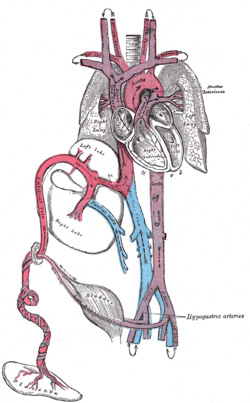Ligamentum venosum
From Wikipedia, the free encyclopedia
| Ligamentum venosum | |
|---|---|
 | |
| The ligamentum venosum courses along the visceral/posterior aspect of the liver in the fossa for ductus venosum, which separates the caudate lobe and the left lobe. | |
 | |
| Fetal circulation. The ductus venosus (red), which becomes the ligamentum venosum, connects the umbilical vein to the inferior vena cava. | |
| Latin | Ligamentum venosum |
| Gray's | subject #139 540 |
| Precursor | ductus venosus |
The ligamentum venosum is the fibrous remnant of the ductus venosus of the fetal circulation. Usually, it is attached to the left branch of the portal vein within the porta hepatis (gateway to the liver). It may be continuous with the round ligament of liver (ligamentum teres hepatis).
It is invested by the peritoneal folds of the lesser omentum within a fissure on the visceral/posterior surface of the liver between the caudate and main parts of the left lobe.
It is grouped with the liver in Terminologia Anatomica.[1]
References
- ↑ Federative Committee on Anatomical Terminology (1998). Terminologia anatomica: international anatomical terminology. Thieme. pp. 54–. ISBN 978-3-13-114361-7. Retrieved 23 June 2010.
External links
- liver at The Anatomy Lesson by Wesley Norman (Georgetown University) (liverinferior)
| |||||||||||
| |||||||||||||||||||||
This article is issued from Wikipedia. The text is available under the Creative Commons Attribution/Share Alike; additional terms may apply for the media files.